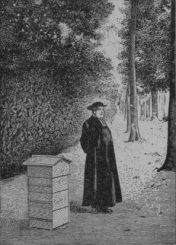
Warré plans
Warré methods
Warré modifications
Warré precursors
Groups / Fora
Google
e-group
Biobees.com
forum
Abbé Warré's book
Beekeeping for All:
One peculiarity of the People's Hive is its quilt (coussin in the original French) which comprises a 100mm deep wooden frame, the same size as the boxes below, with a cloth fitted to its underside and filled with some natural insulating material such as chopped straw (chaff), dry leaves or wood shavings etc.
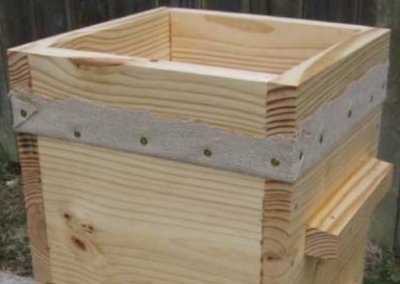
Above: quilt with quilt contents retention cloth secured as recommended in Beekeeping for All.

Above: quilt complete with wood shavings filling and contents retention cloth tacked only under the bottom rim.
Function of the quilt
Warré developed his hive in the climate that prevailed in northern France (Somme, Tours) at the end of the 19th century and beginning of the 20th century. It is therefore probable that it would require modifications to function satisfactorily in climates with extremes of heat and cold. Warré conceived the quilt of the People's Hive as an insulating layer and a route for ventilation of the hive:
This stale air will then continue to occupy the top of the hive, but the cloth lets it
pass and be taken into the quilt.
This escape of stale air draws in fresh air through the hive entrance. As this escape of air is
continuous and under the control of the bees, the fresh air enters only slowly but continuously, to
renew the air in the hive and without making the bees uncomfortable. (p. 54, Beekeeping for All)In a narrow hive like the People's Hive, this dampness cannot travel from the bee cluster, nor cool,
nor condense. It remains above the cluster of bees and ends up by escaping through the cloth covering
the top-bars of the upper box and then passes into the quilt. And this is under the control of the bees
who regulate this escape of moisture by putting more or less propolis on the cloth. (p. 152, Beekeeping for All)
But it would appear that significant mass flow of air through the propolised top-bar cloth, quilt contents and mouse board in the roof seems highly unlikely. Therefore, the ventilation in the hive is not like a chimney.
However, as moist air is lighter than dry air, there is no doubt a relatively high water vapour pressure under the top-bar cloth and even though it is propolised, it has at least some vapour permeability. In which case, any moist air reaching the upper cooler layers of the quilt contents or the underside of the mouse board is likely to reach the dew point and condense, especially in winter and more so in climates that have very cold winters. The danger then is that the condensate freezes, thaws in the spring and drips onto the cluster, thereby threatening its survival.
The following photo illustrated this issue in a Warré-type quilt on a Langstroth hive:
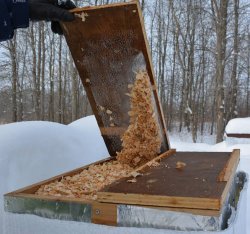 Photo: Norbert
Lukowski, Cumberland, Ontario
Photo: Norbert
Lukowski, Cumberland, Ontario
Condensate has frozen under the crown board and in the shavings.
Modifications of the top of the hive
Several Warré beekeepers in colder climates have reported such condensation and have dealt with it in different ways. John Moerschbacher (Alberta) did away with the quilt altogether and substituted a feeder that in winter functions as a condensate trap and provides a top entrance. For details click here.
Larry Garrett (Indiana) has introduced modifications while retaining a box with an insulating function under the roof. In winter a cover with a small entrance in it is placed above the top-bars (orange layer in photo below). Above that is a box containing kraft paper backed fibreglass insulation. The kraft paper is a vapour barrier and is facing downwards towards the colony. Other types of vapour barrier and efficient insulation for the box filling are conceivable.
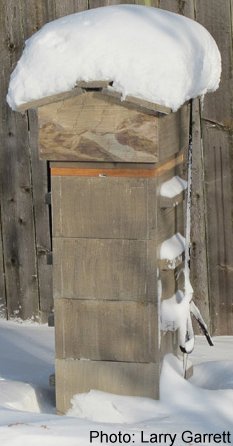
A radical departure from Warré's top-of-hive configuration was made by Jean-Marie Frèrès and Jean-Claude Guillaume. While they praised Warré basic hive concept, they felt that the top-bar cloth, quilt and roof arrangement were sub-optimal. They made the top-bar cloth potentially fully permeable to mass flow and provided an insulated and highly ventilated cavity above that. For details click here.
Bruno Bec (SE France) has also redesigned the top-of-hive arrangement. It is made from a standard Warré box with metal mesh dividing the inside into two equally sized compartments. The mesh mouse-proofs the hive top. There are ventilation slots near the bottom of the upper compartment. These slots are sheltered by the roof overhang to minimise rain ingress. The insulation comprises a slab of chemical-free hemp fibres 100 mm deep and 320 x 320 mm square. This is cut from hemp insulation used in timber-frame house construction and is particularly resistant to insect damage. The slightly larger size than the Warré box internal size gives it an interference fit in the box and no other securing is necessary.
In the warm months the quilt insulation is placed above the mesh and thus shields the hive from the heat of the sun under the metal roof. At this time, the space above the top-bar cover cloth can be used to insert a feeder. In the cool months the insulation rests on the top-bar cover cloth. The vented space above the insulation then prevents condensation from forming.
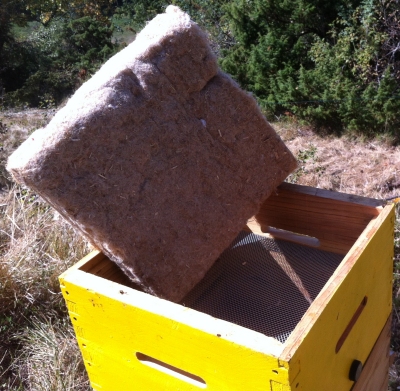
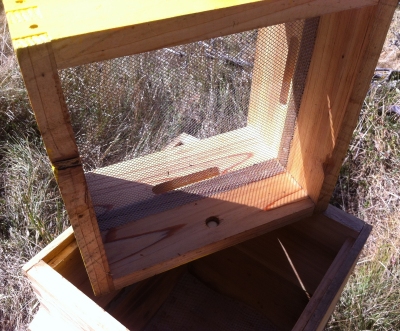
The quilt is covered with a standard flat roof with metal sheet as the weatherproofing.
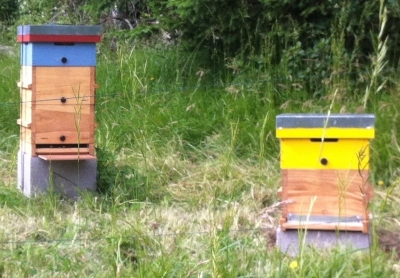
The purpose of this design is to make the top-of-hive setup simpler and lighter than the standard Warré arrangement with its double-pitched roof. At the time of writing, Bec's system has been used with success for two winters on 5 hives.
Of the ventilation slits, Bruno Bec writes that they "are not round like those in the roof system of Frères & Guillaume. This is in order to:
- avoid birds building a nest below the roof
- allow lifting a belt to fix the hive to the ground (high winds in winter)
- wide the size of a hand to ease the manipulation
- less high than a round hole of the same surface to reduce water entry when raining on windy days
The position of the mesh and the thickness of the insulation slab allows two slabs to be used, one above plus one below the mesh, in case of Siberian temperatures. But with only one slab I have measured a difference of 10 to 12°C between the external and the internal side if the insulation. This works in both directions, positive in winter, negative in summer."
There is the possibility that water could penetrate the joint between the quilt box and the top box of the hive, the joint in which the top-bar cloth is situated. In the Frèrès & Guillaume top-of-hive setup this penetration is prevented by a batten fixed round the bottom perimeter of the quilt box, covering that joint. Bruno Bec gets round the problem by making the top-bar cloth the same size as the inside of the hive. Furthermore his 'cloth' is the plastic mesh often used to collect propolis.
More about Bruno Bec's beekeeping here.
Precursors of the quilt
As regards the quilt in particular, Warré also had precursors who recommended a similar device.
One is the Rev. J. G. Digges MA,2 who was a member of the examining board of the Irish Beekeepers' Association and editor of the Irish Bee Journal. He writes: 'Sheets and quilts are required upon the frames ... to preserve heat; to prevent draught; and to keep the bees from ascending into the roof. The sheet is made of bed ticking or unbleached calico. The quilts should be of felt, carpet or other warm material. [...] From the sheet a circular piece may be all but cut out from the centre, so that it can be turned back when feeding is in progress to give bees access to the feeder; at other times it can be restored to its original position. [...] In summer, a sheet of American cloth [a sturdy, enamelled oilcloth], enamelled side down, may with advantage be used instead of a sheet of ticking; but at other seasons it is advisable that the covering should be of porous material to permit evaporation of the moisture of the hive. Straw mats or chaff cushions are sometimes used on the quilts. In winter, it is useful to cover the brood-nest and quilts with an empty crate or other bottomless box, having a piece of canvas or calico tacked underneath, and filled with cork-dust, chaff, or other warm material.'
Digges apparently has three layers on the frames, a top-bar cloth (e.g. calico), a quilt (e.g. felt) and a tray filled with a natural insulator (e.g. chaff) that performs the same function as the quilt in the People's Hive. Notice that he envisages water vapour passing through the quilt in winter.
Twenty-six years before Digges' first edition, we find Frank R. Cheshire3 describing the same kind of device. The Cheshire hive incorporated what he called a 'chaff tray'.
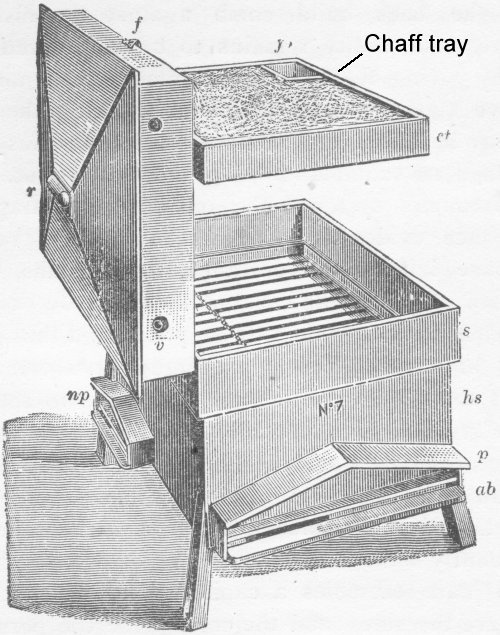 The Cheshire hive (Fig. 17)
The Cheshire hive (Fig. 17)
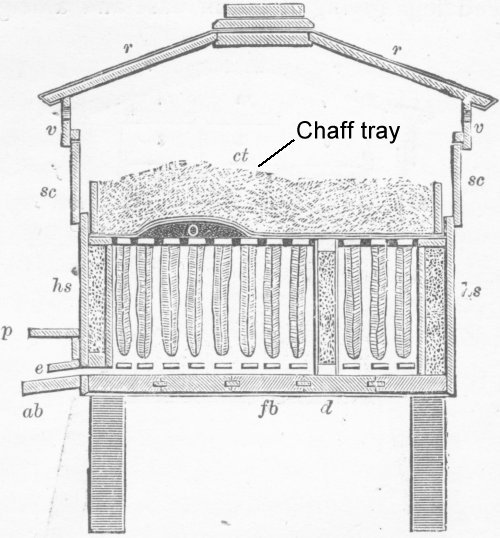 Section view of the Cheshire hive (Fig. 19)
Section view of the Cheshire hive (Fig. 19)
Cheshire's setup is virtually identical to Warré's in that both use a top-bar cloth of hessian (jute sacking) and both a wooden framed 'quilt'. Cheshire writes: 'Over the frames is placed a waterproof cloth, a piece of hessian or unbleached calico, according to the season; while at all times when two supers are not on the hive, a chaff-tray (ct Figs. 17 and 19)--unspeakably superior to carpeting--is used over the frames. This chaff-tray consists of a ring of wood, 3in. or 4in. deep, with a bottom of rather loose sacking; so that, when it is placed in position, the chaff beds itself down completely over the top of the hive, fitting any irregularity, and preventing all needless leak of heated air. Fig 19 shows o, a flour cake, under the chaff tray, and explains the statement just made. The loss of numberless colonies is no doubt traceable to defects in the top covering, the non-conductive qualities and close fitting of which are far more important than those of the hive itself.'
In the 'chaff tray' is chopped straw. Here is Pettigrew, a 19th century skep beekeeper, on straw as a material for the top of hives:
"The latest improvement to the bar-frame hive consists in the
substitution of "a quilt " for the wooden top. The inventor is of course a
dealer, and till the invention was completed, no one heard of the wooden tops being at
fault. In the language of the inventor, we shall now let the reader have a description of
the quilt. -- He says : " For all crown covers, it is the very best for winter use,
because it permits the escape of all noxious vapours from the hive, as soon as they are
generated. The quilt arrangement comprises a piece of carpet, or other material of hard
texture, with a hole in the centre for feeding purposes; two or three thicknesses of felt,
flannel, or other porous materials, each with a hole in its centre of similar size as that
in the carpet; a piece of perforated zinc or vulcanite as a feeding-stage; a pad like a
kettle-holder to lay upon the vulcanite; a folded sack, blanket, or rug laid upon the
whole,—after which the roof may be put on, and should be fastened to prevent blowing
off. If closely covered, the whole arrangement will become sopping wet, simply because the
vapours cannot escape."
I think no intelligent bee-keeper, after reading this description, will covet or ever
purchase such lids; and it grieves one to know that, after discovering the unsuitability
of wood as material for hives, the inventor has not hit upon something better and more
sightly than a quilt made of carpet, felt, vulcanite, a pad, a folded sack or blanket, and
a roof. This quilt will soon be cast aside for something very much better. What will it
be? We cannot tell the reader what will come next, but we agree with Mr Quinby that there
is "nothing equal to straw for straining moisture out of hives." If wood is
unsuitable for the crowns or tops of hives, it is equally unsuitable for their
sides."4
References
1) Émile Warré, Beekeeping For All, 2010, trans. from L'Apiculture Pour Tous, (12th ed. 1948) Northern Bee Books. PDF available (see link on left).
2) Digges, J. G. (1910) The Practical Bee Guide -- A Manual of Modern Beekeeping. 2nd Edition. Simpkin, Marshall, Hamilton, Kent & Co. Ltd., London. Pages 50 & 51. Downloadable at www.archive.org.
3) Cheshire, Frank Richard (1888) Bees and Beekeeping -- Scientific and Practical. Vol II. Practical. The Bazaar, Exchange and Mart Office, London. Pages 58-61.
4) Pettigrew, A. (1875) Handy Book of Bees.